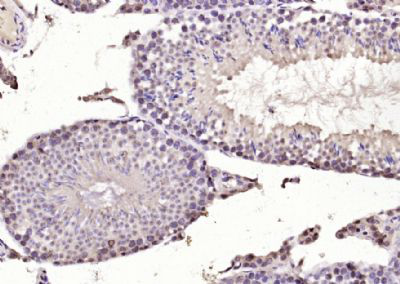产品货号 : mlR12332
英文名称 : DYRK2
中文名称 : 双特异性酪氨酸磷酸化调节激酶DYRK2抗体
别 名 : 1810038L18Rik; Dual specificity tyrosine (Y) phosphorylation regulated kinase 2; Dual specificity tyrosine phosphorylation regulated kinase 2; Dual specificity tyrosine-phosphorylation-regulated kinase 2; DYRK2; DYRK2_HUMAN; EC 2.7.12.1; FLJ21217; FLJ21365.
研究领域 : 细胞生物 神经生物学 信号转导 激酶和磷酸酶
抗体来源 : Rabbit
克隆类型 : Polyclonal
交叉反应 : Human, Mouse, Rat, Dog, Pig, Cow, Horse, Rabbit,
产品应用 : ELISA=1:500-1000 IHC-P=1:400-800 IHC-F=1:400-800 ICC=1:100-500 IF=1:100-500 (石蜡切片需做抗原修复)
not yet tested in other applications.
optimal dilutions/concentrations should be determined by the end user.
分 子 量 : 67kDa
细胞定位 : 细胞核 细胞浆
性 状 : Lyophilized or Liquid
浓 度 : 1mg/ml
免 疫 原 : KLH conjugated synthetic peptide derived from human DYRK2:425-480/601
亚 型 : IgG
纯化方法 : affinity purified by Protein A
储 存 液 : 0.01M TBS(pH7.4) with 1% BSA, 0.03% Proclin300 and 50% Glycerol.
保存条件 : Store at -20 °C for one year. Avoid repeated freeze/thaw cycles. The lyophilized antibody is stable at room temperature for at least one month and for greater than a year when kept at -20°C. When reconstituted in sterile pH 7.4 0.01M PBS or diluent of antibody the antibody is stable for at least two weeks at 2-4 °C.
PubMed : PubMed
产品介绍 : Dyrk is the homolog of the Drosophila mnb (minibrain) gene, which is required for neurogenesis (1–3). Dyrk is a dual-specificity tyrosine kinase and serine/threonine kinase, which is itself regulated by tyrosine phosphorylation (1). Several mammalian Dyrk related proteins have been identified and are thought to compose a family of dual specificity protein kinases (4). Dyrk family members, including Dyrk1A (originally Dyrk), Dyrk1B, Dryk1C, Dyrk2, Dyrk3, Dyrk4A and Dyrk4B, are thought to be involved in diverse cellular functions (4). Dyrk1A is a candidate gene that may be involved in Downs syndrome, and it has been found to be somewhat overexpressed in Downs syndrome (1,5). Two isoforms of human fetal brain Dyrk2 exist: a deduced 528-amino acid protein and a protein containing 73 additional amino acids at the amino terminus (4). Dyrk3 is strongly expressed in testis, only after the onset of spermatogenesis, and very weakly expressed in spleen and adrenal gland (1). The genes which encode Dyrk2 and Dyrk3 map to human chromosomes 12 and 1q32, respectively (4).
Function:
Role in the regulation of cellular growth and/or development. Regulates TP53 by phosphorylation on Ser-46 to induce apoptosis in response to DNA damage, functioning downstream of ATM. Inactivates GYS1 by phosphorylation at Ser-641, and potentially also a second phosphorylation site, thus regulating glycogen synthesis. Phosphorylates EIF2B5 at Ser-544, enabling its subsequent phosphorylation and inhibition by GSK3, and may play a more general role in the priming of GSK3 substrates.
Subunit:
Component of an E3 ligase complex containing DYRK2, EDD/UBR5, DDB1 and VPRBP (EDVP complex). Interacts directly with EDD/UBR5, DDB1 and VPRBP. Interacts with SIAH2 and MDM2. Interacts with MAP3K10 and NFATC1. May also interact with CCNL2.
Subcellular Location:
Cytoplasm. Nucleus. Translocates into the nucleus following DNA damage.
Tissue Specificity:
Testis, after the onset of spermatogenesis.
Post-translational modifications:
Autophosphorylates cotranslationally on the second tyrosine residue in the Tyr-X-Tyr motif in the activation loop, but once mature, does not have any protein tyrosine kinase activity. Phosphorylated at Thr-106 and Ser-442 by ATM in response to genotoxic stress.
Under normal conditions, polyubiquitinated in the nucleus by MDM2, leading to its proteasomal degradation. Phosphorylation on Thr-106 and Ser-442 by ATM in response to genotoxic stress disrupts MDM2 binding and prevents MDM2-mediated ubiquitination and subsequent proteasomal degradation. Polyubiquitinated by SIAH2, leading to its proteasomal degradation. Polyubiquitinated by SIAH2 occurs under normal conditions, and is enhanced in response to hypoxia.
Similarity:
Belongs to the protein kinase superfamily.
CMGC Ser/Thr protein kinase family. MNB/DYRK subfamily.
Contains 1 protein kinase domain.
SWISS:
Q92630
Gene ID:
8445
Important Note:
This product as supplied is intended for research use only, not for use in human, therapeutic or diagnostic applications.
产品图片












